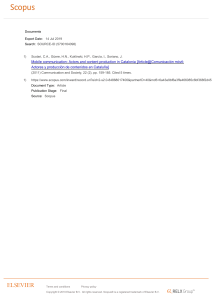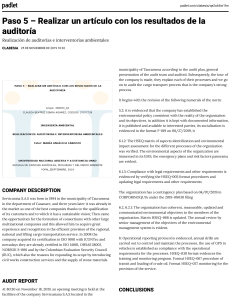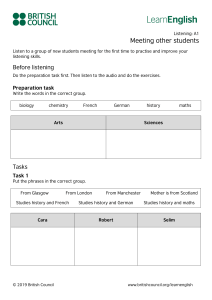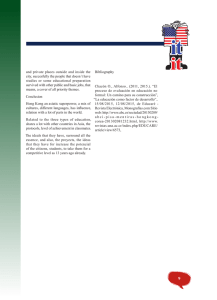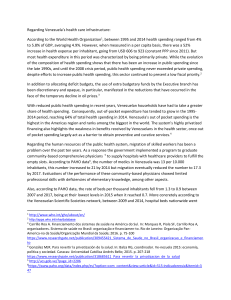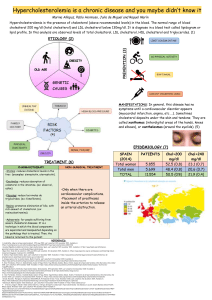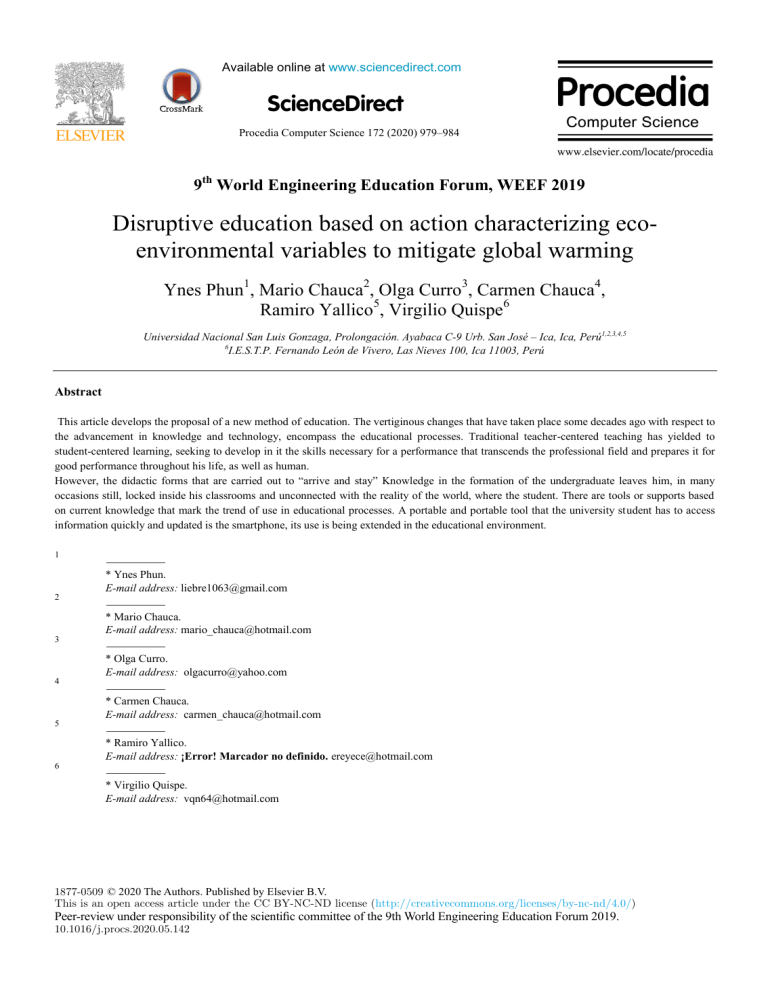
Available online at www.sciencedirect.com ScienceDirect Available online at www.sciencedirect.com Procedia Computer Science 00 (2019) 000–000 ScienceDirect www.elsevier.com/locate/procedia Procedia Computer Science 172 (2020) 979–984 9th World Engineering Education Forum, WEEF 2019 Disruptive education based on action characterizing ecoenvironmental variables to mitigate global warming Ynes Phun1, Mario Chauca2, Olga Curro3, Carmen Chauca4, Ramiro Yallico5, Virgilio Quispe6 Universidad Nacional San Luis Gonzaga, Prolongación. Ayabaca C-9 Urb. San José – Ica, Ica, Perú1,2,3,4,5 6 I.E.S.T.P. Fernando León de Vivero, Las Nieves 100, Ica 11003, Perú Abstract This article develops the proposal of a new method of education. The vertiginous changes that have taken place some decades ago with respect to the advancement in knowledge and technology, encompass the educational processes. Traditional teacher-centered teaching has yielded to student-centered learning, seeking to develop in it the skills necessary for a performance that transcends the professional field and prepares it for good performance throughout his life, as well as human. However, the didactic forms that are carried out to “arrive and stay” Knowledge in the formation of the undergraduate leaves him, in many occasions still, locked inside his classrooms and unconnected with the reality of the world, where the student. There are tools or supports based on current knowledge that mark the trend of use in educational processes. A portable and portable tool that the university student has to access information quickly and updated is the smartphone, its use is being extended in the educational environment. 1 2 3 4 5 6 * Ynes Phun. E-mail address: [email protected] * Mario Chauca. E-mail address: [email protected] * Olga Curro. E-mail address: [email protected] * Carmen Chauca. E-mail address: [email protected] * Ramiro Yallico. E-mail address: ¡Error! Marcador no definido. [email protected] * Virgilio Quispe. E-mail address: [email protected] 1877-0509 © 2019 The Authors. Published by Elsevier Ltd. This is an open access article under the CC BY-NC-ND license (http://creativecommons.org/licenses/by-nc-nd/3.0/). Selection and peer-review under responsibility of the scientific committee of WEEF 2019 1877-0509 © 2020 The Authors. Published by Elsevier B.V. This is an open access article under the CC BY-NC-ND license (http://creativecommons.org/licenses/by-nc-nd/4.0/) Peer-review under responsibility of the scientific committee of the 9th World Engineering Education Forum 2019. 10.1016/j.procs.2020.05.142 980 2 Ynes Phun et al. / Procedia Computer Science 172 (2020) 979–984 ¡Error! Marcador no definido.Author name / Procedia Computer Science 00 (2019) 000–000 One of the current supports to the current educational process, is the neurodidactics that promotes the autonomy of the student so that he develops self-regulation of his learning by working on his Executive Functions, suggesting to the teacher the use of constant motivation and the sensory experience that facilitates the reconnections neuronal those that permeate a more stable and lasting learning, although adaptable and modifiable. In order to raise awareness in the mitigation of global warming, first-cycle students of a public university designed and applied an instrument for observing environmental quality of water, air and soil, characterizing feasible indicators of measurement in the urban area of residence. The modality of active learning has been applied, modified, in a mixed design research, applying a visual didactic process, a modeling of selection of indicators and design of an instrument for observing environmental indicators for its subsequent application in assigned areas of the urban area of the city, applying a semi-structured questionnaire to verify the level of awareness and learning. It is concluded that the application of disruptive strategies such as the use of apps for smartphones, the design and subsequent application of an instrument developed by the students themselves and the ability to "measure" the level of pollution of their area of residence facilitate environmental awareness to mitigate global warming by adopting actions towards a sustainable lifestyle. With the purpose of raising awareness on climate change mitigation, first-cycle students of a public university designed and applied an instrument for observing environmental quality of water, air and soil, characterizing feasible indicators of measurement in the urban area of?? Residence. Subject. Finally they show up primary results of the application of the method. The article presenting some advantages and disadvantages of the method proposed based on the experience gained, as well as some specifications and requirements for the application Successful method. © 2020 The Authors. Published by Elsevier B.V. © 2019 The Authors. Published by Elsevier Ltd. This is an open access article under the CC BY-NC-ND license (http://creativecommons.org/licenses/by-nc-nd/4.0/) This is an open access article under the CC BY-NC-ND license (http://creativecommons.org/licenses/by-nc-nd/3.0/). Peer-review under responsibility of the scientific committee of the 9th World Engineering Education Forum 2019. Keywords: Disruptive education; Eco-environmental variables; Sensitize; Mitigation; Global warming 1. Introduction When observing the current globalized context and perceiving the consequences of anthropic action on the environment in the form of diverse global problems, climate change and pollution stand out; this is why it has become a worldwide necessity to reverse the processes of involution to which man has led the planet. This is a powerful reason to introduce changes in the training of new professionals. But a change, at any educational level and even more at the level of higher education, so that it is effective, enduring and responding to the need that demands to be satisfied cannot fail to consider the advances in the knowledge of the world, because that would decontextualize it. . Society demands competent people, self-regulated and committed to the world and with themselves, who are able to know how to make timely decisions. On the other hand, the educational institutions within their possibilities, must provide opportunities for people to develop their potential and at the same time, grant the vision of adopting a lifestyle that leads to sustainable human development, in harmony with the environment throughout his life, also as a human (De Zubiría Samper, 2013). Considering the above mentioned, in the stages of human development, that of adolescence culminates around twenty years; that is, when the student graduates from undergraduate (21-22 years of age), following regular studies, this vital stage is completed, which is where the capacity for planning, decision making, self-regulation and ethical training, centralized processes is completed in the prefrontal lobe of the brain constituting the Executive Functions (Pardos Véglia, 2018). Precisely, it is the propitious period to introduce improvements in the teaching-learning system, since at the nervous system level the brain still has great plasticity. The current cultural environment promotes a living and unfolding in a world full of permanent and varied technology, images and sound, which become multi-stimulus for the nervous system in formation; On the one hand, Ynes Phun et al. / Procedia Computer Science 172 (2020) 979–984 ¡Error! Marcador no definido.Author name / Procedia Computer Science 00 (2019) 000–000 981 3 an orientation that enables the individual adoption of forms of care control is necessary; but on the other hand it is also an opportunity to use visual and auditory stimuli of short duration as a means of learning. Likewise, young generations are immersed since before they were born, in a context of technology to such a degree that they are dependent on it; although it could be an obstacle for Education if we look with the eyes of traditional educational processes; It is actually an opportunity that can be used precisely in human formation processes. Because a condition for learning to occur is that the student must be motivated, one has part of the advanced path with the use of technology since young people are highly motivated with their use and updated management; The permanent use of the smartphone has become a normal part in the lives of young people and can be used for the benefit of their education. Figueroa (2016) and Rodríguez et al (2017) mention that it is a portable and easily accessible tool to obtain updated information. Only the update in its use and management options is necessary, by the teaching. Currently, the student has become the central axis of every educational process and their learning must become meaningful; that is, to become a useful, valid, applicable knowledge for him. For this reason, this study has been directed to sensitize the young student in the local environmental problem, from his own experience, making it he who in the work team, elaborate by observation the indicators of measurement of pollution in urban areas, design or investigate in each procedure choosing their measuring instruments to be applied by themselves in collaborative work. In other words, efforts have been made to encourage autonomous work by developing sociality. 982 4 Ynes Phun et al. / Procedia Computer Science 172 (2020) 979–984 ¡Error! Marcador no definido.Author name / Procedia Computer Science 00 (2019) 000–000 2. Material and method A. Sample Intentional, students of two of the four sections of the second semester of studies that study the subject Environmental Education, being n = 64, between ages from 16 to 33 years old (1.6%); being 67% of the feminine sex and 33% of the masculine one. B. Method Design; mixed, basic research, descriptive-correlational type. The following stages have been developed: a) In the previous training, in a classroom environment, 1 to 3 short videos were used in each session with a duration of one minute thirty to five minutes to illustrate and explain each global environmental problem (climate change, air pollution, soil, water, deforestation, land degradation, water scarcity and energy use, loss of biodiversity and natural resources, waste and overfishing); b) Subsequently, with the support of tutors and the work team, they self-managed their learning creatively in the design of an instrument for observing environmental indicators, including the use of smart mobile applications. For the observation of each indicator, each team developed a procedure. c) Sampling areas vulnerable to environmental pollution were randomly assigned in the urban area of the city, applying the previously designed and readjusted instrument, product of a pilot test. The following zone denomination was used: residential zone (R), commercial zone (C), mixed zone RC (Residential-Commercial), mixed zone C I (Commercial-Industrial) (ECA noise, 2003). d) After the application of the instrument and analysis of results, a semi-structured questionnaire was applied in order to verify the level of awareness and learning.. 3. Results Finding critical levels of pollution for a healthy urban environment oriented towards sustainable development, the results are shown in a qualitative and quantitative way based on statistical analysis. a) There were 13 organized working groups. The environmental pollution indicators, feasible for measurement considered by the majority of the groups, were: - For water: turbidity (100%), organoleptic characteristics (smell and taste) (92.28%), pH value (100%), absence of impurities (46.14%). - For air: visibility level (92.28%), ambient temperature (92.28%), air aroma (92.28%), and sound intensity (100%). - For soil: degree of presence of plastic waste, various organic waste, liquid waste or similar, other 100% inorganic waste. Table 1. Selection and use of “disruptor” material (use of smartphone technology) by students, in the design of a pollution observation instrument For ambient temperature % For sound intensity % To measure time (duration) % Ynes Phun et al. / Procedia Computer Science 172 (2020) 979–984 ¡Error! Marcador no definido.Author name / Procedia Computer Science 00 (2019) 000–000 App thermometer simple v.1 App Weather Subtotal = 02 30,76 App sound meter App chronometer 23,07 983 5 53,83 App Decibel -v.8.0 23,07 App Sound meter 15,38 (SPL) – v.3.5.0 Sub-total = 03 Subtotal = 01 Total “disruptor” material selected and used = 06 smartphone app 23,07 It is agreed with Figueroa (2016) and Rodríguez (2017) that the use of smartphones support the academic training of the higher level student. It also agrees with De Zubiría Samper (2013), as students have strengthened their self-learning by planning their activity. Table 2. Frequency and percentage of areas suitable for environmental quality of water for human consumption in urban areas, according to indicators, 2019. N° Indicator f % 1 Transparency (Turbidity) 10 76,9 2 Organoleptic characteristics (ODOR: odorless) 10 76,9 3 Organoleptic characteristics (TASTE: tasteless) 8 62 4 Value de PH (5,5-9,0) 12 92,3 13 100 5 Absence of Impurities Table 3. Frequency and percentage of areas suitable for environmental air quality, according to indicators and urban application area, in urban areas, 2019. APPLICATION AREAS URBAN ZONE C I ZONE COMERC ZONE R C ZONE RESIDENC TOTAL % 83,3 100 83,3 66,7 66,7 % 69,23 92,30 76,92 53,84 61,54 APTO N° INDICATOR 6 7 8 9 10 Degree of visibility Ambient temperature scent Sound intensity Solid particles in suspension Zone C I: Commercial-Industrial Zone Zone RC: Zona Residencial-comercial % 50 100 0 50 50 % 50 50 100 50 50 % 34 100 50 34 66,7 Table 4. Frequency and percentage of areas suitable for environmental quality of the soil in urban areas, according to indicators, 2019 f % N° Indicator 10 Presence of plastic waste 8 61,54 11 Presence of various organic waste 8 61,54 12 Presence of liquid waste or similar 8 61,54 Ynes Phun et al. / Procedia Computer Science 172 (2020) 979–984 ¡Error! Marcador no definido.Author name / Procedia Computer Science 00 (2019) 000–000 984 6 13 Other inorganic waste 7 53,84 4. Conclusions Of the 4 indicators considered as feasible for soil pollution measurement, the one with the greatest presence is “other inorganic waste” (53.85%). In 13 studied areas, the pH value and the absence of impurities are the predominant indicators to qualify as environmental quality of water for human consumption in urban areas. 98% of students who carried out this activity (n = 64) were satisfied and motivated with the results obtained, showing interest in the participation and organization of actions to mitigate the effects of urban environmental problems. 5. References [1] [2] [3] [4] [5] De Zubiría Samper, Julián. (2013). El maestro y los desafíos a la educación en el siglo XX!. REDIPE 825. Red Iberoamericana de Pedagogía. 17pp. Figueroa Portilla, Carlos Saussure. (2016). El uso del smartphone como herramienta para la búsqueda de información en los estudiantes de pregrado de educación de una universidad de Lima Metropolitana. Educación, 25(49), 29-44. https://dx.doi.org/10.18800/educacion.201602.002. Pardos Véglia, Alexandra y González Ruiz, María. (2018). Intervención sobre las Funciones Ejecutivas (FE) desde el contexto educativo. Neurodidáctica en el aula: transformando la educación, Revista Iberoamericana de Educación, 78(1), 13-25. PCM, (2003). Estándares nacionales de calidad ambiental para ruido, D.S.085,2003. Título II, Cap. 1, Art. 5° y 6°. Rodríguez, H., Restrepo, L y García, G. (2017). Habilidades digitales y uso de teléfonos inteligentes (smartphones) en el aprendizaje en la educación superior. Revista Virtual Universidad Católica del Norte, 50, 126-146. Recuperado de http://revistavirtual.ucn.edu.co/index.php/RevistaUCN/article/view/816/1334.


